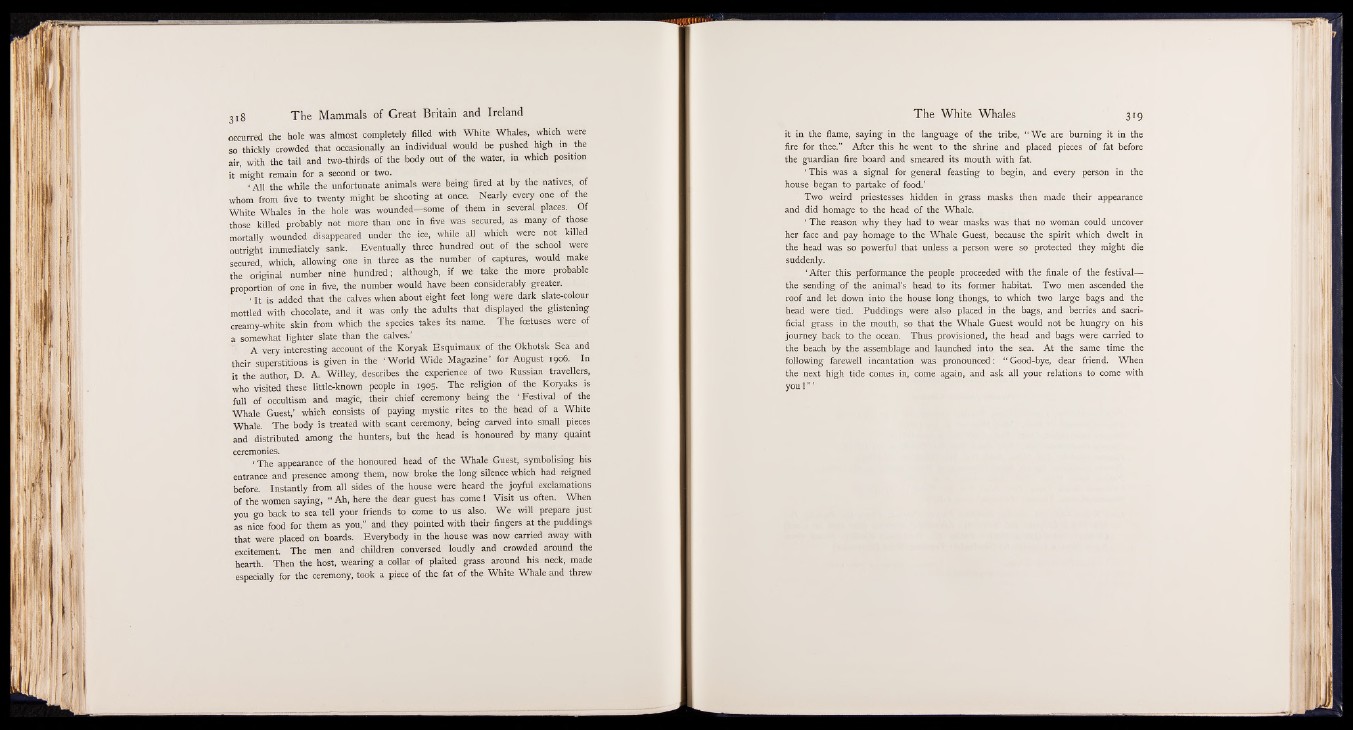
occurred the hole was almost completely filled with White Whales, which were
so thickly crowded that occasionally an individual would be pushed high in the
air, with the tail and two-thirds of the body out of the water, in which position
it might remain for a second or two.
‘ All the while the unfortunate animals were being fired at by the natives, of
whom from five to twenty might be shooting at once. Nearly every one of the
White Whales in the hole was wounded— some of them in several places. Of
those killed probably not more than one in five was secured, as many of those
mortally wounded disappeared under the ice, while all which were not killed
outright immediately sank. Eventually three hundred out of the school were
secured, which, allowing one in three as the number of captures, would make
the original number nine hundred; although, if we take the more probable
proportion of one in five, the number would have been considerably greater.
■ It is added that the calves when about eight feet long were dark slate-colour
mottled with chocolate, and it was only the adults that displayed the glistening
creamy-white skin from which the species takes its name. The foetuses were of
a somewhat lighter slate than the calves.
A very interesting account of the Koryak Esquimaux of the Okhotsk Sea and
their superstitions is given in the ‘World Wide Magazine' for August 1906. In
it the author, D. A. Willey, describes the experience of two Russian travellers,
who visited these little-known people in 1905. The religion of the Koryaks is
full of occultism and magic, their chief ceremony being the 'Festival of the
Whale Guest,’ which consists of paying mystic rites to the head of a White
Whale. The body is treated with scant ceremony, being carved into small pieces
and distributed among the hunters, but the head is honoured by many quaint
ceremonies.
‘ The appearance of the honoured head of the Whale Guest, symbolising his
entrance and présence among them, now broke the long silence which had reigned
before. Instantly from all sides of the house were heard the joyful exclamations
of the women saying, “ Ah, here the dear guest has come I Visit us often. When
you go back to sea tell your friends to come to fis» also. We will prepare just
as nice food for them as you,” and they pointed with their fingers at the puddings
that were placed on boards. Everybody in the house was now carried away with
excitement. The men and children conversed loudly and crowded around the
hearth. Then the host, wearing a collar of plaited grass around his neck, made
especially for the ceremony, took a piece of the fat of the White Whale and threw
it in the flame, saying in the language of the tribe, “ We are burning it in the
fire for thee.” After this he went to the shrine and placed pieces of fat before
the guardian fire board and smeared its mouth with fat.
‘ This was a signal for general feasting to begin, and every person in the
house began to partake of food.’
Two weird priestesses hidden in grass masks then made their appearance
and did homage to the head of the Whale.
‘ The reason why they had to wear masks was that no woman could uncover
her face and pay homage to the Whale Guest, because the spirit which dwelt in
the head was so powerful that unless a person were so protected they might die
suddenly.
‘After this performance the people proceeded with the finale of the festival--*
the sending of the animal’s head to its former habitat. Two men ascended the
roof and let down into the house long thongs, to which two large bags and the
head were tied. Puddings were also placed in the bags, and berries and sacrificial
grass in the mouth, so that the Whale Guest would not be hungry on his
journey back to the ocean. Thus provisioned, the head and bags were carried to
the beach by the assemblage and launched into the sea. At the same time the
following farewell incantation was pronounced: “ Good-bye, dear friend. When
the next high tide comes in, come again, and ask all your relations to come with
you I” ’